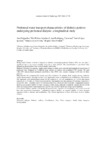Mostrar o rexistro simple do ítem
Peritoneal water transport characteristics of diabetic patients undergoing peritoneal dialysis: a longitudinal study
| dc.contributor.author | Fernandes, Ana | |
| dc.contributor.author | Ribera-Sánchez, Roi | |
| dc.contributor.author | Rodríguez Carmona, Ana | |
| dc.contributor.author | López-Iglesias, Antía | |
| dc.contributor.author | Leite-Costa, Natacha | |
| dc.contributor.author | Pérez-Fontán, Miguel | |
| dc.date.accessioned | 2017-08-22T10:54:29Z | |
| dc.date.available | 2017-08-22T10:54:29Z | |
| dc.date.issued | 2017-06-21 | |
| dc.identifier.citation | Fernandes A, Ribera-Sánchez R, Rodríguez-Carmona A, López-Iglesias A, Leite-Costa N, Pérez Fontán M. Peritoneal water transport characteristics of diabetic patients undergoing peritoneal dialysis: a longitudinal study. Am J Nephrol. 2017;46(1):47-54 | es_ES |
| dc.identifier.issn | 0250-8095 | |
| dc.identifier.issn | 1421-9670 | |
| dc.identifier.uri | http://hdl.handle.net/2183/19347 | |
| dc.description.abstract | [Abstract] Background: Volume overload is frequent in diabetics undergoing peritoneal dialysis (PD), and may play a significant role in the excess mortality observed in these patients. The characteristics of peritoneal water transport in this population have not been studied sufficiently. Method: Following a prospective, single-center design we made cross-sectional and longitudinal comparisons of peritoneal water transport in 2 relatively large samples of diabetic and nondiabetic PD patients. We used 3.86/4.25% glucose-based peritoneal equilibration tests (PET) with complete drainage at 60 min, for these purposes. Main Results: We scrutinized 59 diabetic and 120 nondiabetic PD patients. Both samples showed relatively similar characteristics, although diabetics were significantly more overhydrated than nondiabetics. The baseline PET disclosed lower ultrafiltration (mean 439 mL diabetics vs. 532 mL nondiabetics, p = 0.033) and sodium removal (41 vs. 53 mM, p = 0.014) rates in diabetics. One hundred and nine patients (36 diabetics) underwent a second PET after 12 months, and 45 (14 diabetics) underwent a third one after 24 months. Longitudinal analyses disclosed an essential stability of water transport in both groups, although nondiabetic patients showed a trend where an increase in free water transport (p = 0.033) was observed, which was not the case in diabetics. Conclusions: Diabetic patients undergoing PD present lower capacities of ultrafiltration and sodium removal than their nondiabetic counterparts. Longitudinal analyses disclose an essential stability of water transport capacities, both in diabetics and nondiabetics. The clinical significance of these differences deserves further analysis. | es_ES |
| dc.language.iso | eng | es_ES |
| dc.publisher | Karger | es_ES |
| dc.relation.uri | http://dx.doi.org/10.1159/000477829 | es_ES |
| dc.subject | Peritoneal dialysis | es_ES |
| dc.subject | Diabetes mellitus | es_ES |
| dc.subject | Ultrafiltration | es_ES |
| dc.subject | Free water transport | es_ES |
| dc.subject | Small solute transport | es_ES |
| dc.subject | Overhydration | es_ES |
| dc.title | Peritoneal water transport characteristics of diabetic patients undergoing peritoneal dialysis: a longitudinal study | es_ES |
| dc.type | info:eu-repo/semantics/article | es_ES |
| dc.rights.access | info:eu-repo/semantics/openAccess | es_ES |
| UDC.journalTitle | American Journal of Nephrology | es_ES |
| UDC.volume | 46 | es_ES |
| UDC.issue | 1 | es_ES |
| UDC.startPage | 47 | es_ES |
| UDC.endPage | 54 | es_ES |
Ficheiros no ítem
Este ítem aparece na(s) seguinte(s) colección(s)
-
GI-FENM - Artigos [106]
-
INIBIC-EENM - Artigos [52]






